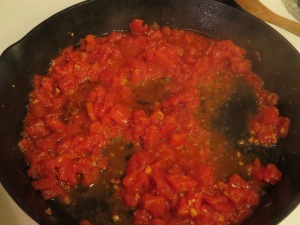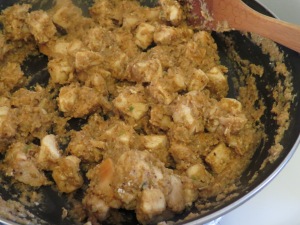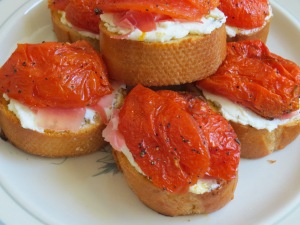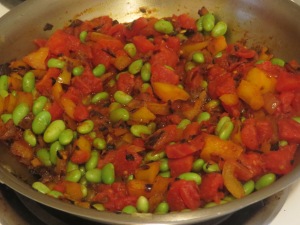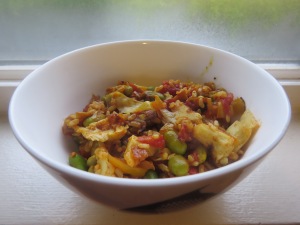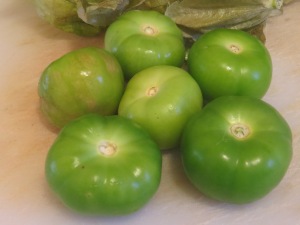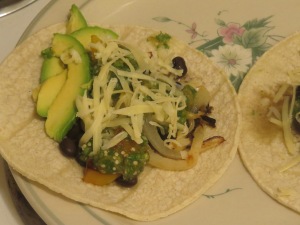Is 2018 just going to be “one of those years”? It hasn’t been exactly easy so far, personally (don’t even get me started on the political cluster%*@&). I’m not going to get into it all here, but suffice to say that 2018 is bringing the challenges. Cooking is one of the ways I cope—it’s a challenge that I welcome into my life, even when it takes time to get it right.
 This shakshuka was in the experimental stage for a while before I deemed it ready for sharing here. Shakshuka—the traditional one, with tomatoes, chickpeas, and feta—is one of my favorite dishes, but even a favorite can use some reinvention. A recipe for eggplant ragout unintentionally provided the inspiration: what if I added eggplant to my shakshuka recipe? From there I took another leap: what if I used mozzarella instead of feta, adding a bit of an Italian vibe to this classic Middle Eastern meal? It sounded delicious , and like something I could easily add to my weeknight repertoire, so I was all in.
This shakshuka was in the experimental stage for a while before I deemed it ready for sharing here. Shakshuka—the traditional one, with tomatoes, chickpeas, and feta—is one of my favorite dishes, but even a favorite can use some reinvention. A recipe for eggplant ragout unintentionally provided the inspiration: what if I added eggplant to my shakshuka recipe? From there I took another leap: what if I used mozzarella instead of feta, adding a bit of an Italian vibe to this classic Middle Eastern meal? It sounded delicious , and like something I could easily add to my weeknight repertoire, so I was all in.
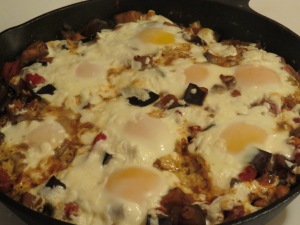 I don’t have anything against eggplant, but I do notice when it’s dominating a dish, and not in a good way. Too much eggplant, and there’s not enough of everything else for it to absorb, which it is so good at. The first version of this dish didn’t have enough tomatoes, and the eggplant, without enough flavors to absorb, was, shall we say, not the most flavorful. Back to the drawing board (or stove, in this case). The next version had double the amount of tomatoes and some oregano, for an extra flavor boost.
I don’t have anything against eggplant, but I do notice when it’s dominating a dish, and not in a good way. Too much eggplant, and there’s not enough of everything else for it to absorb, which it is so good at. The first version of this dish didn’t have enough tomatoes, and the eggplant, without enough flavors to absorb, was, shall we say, not the most flavorful. Back to the drawing board (or stove, in this case). The next version had double the amount of tomatoes and some oregano, for an extra flavor boost.
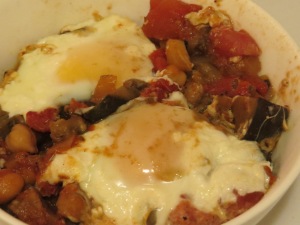 This final version gets the balance right. The eggplant absorbs the tomato and oregano flavors, so you get the entire essence of the dish in every bite. My beloved chickpeas are there, adding texture in a dish of otherwise smooth, soft ingredients. Of course I’m happy with the eggs on top, and covering them with a layer of gooey, melted mozzarella is irresistible. This may not be stereotypical comfort food, but it is for me: a one-skillet dish that’s warm, filling, and makes you feel like all’s right with the world.
This final version gets the balance right. The eggplant absorbs the tomato and oregano flavors, so you get the entire essence of the dish in every bite. My beloved chickpeas are there, adding texture in a dish of otherwise smooth, soft ingredients. Of course I’m happy with the eggs on top, and covering them with a layer of gooey, melted mozzarella is irresistible. This may not be stereotypical comfort food, but it is for me: a one-skillet dish that’s warm, filling, and makes you feel like all’s right with the world.
Which brings me back to 2018 so far. Even when times get tough, good food brings happiness. Some days joy is harder to find, but it’s there. So here’s to more cooking, and many good things ahead.
Eggplant Shakshuka
1 tablespoon olive oil
1 medium onion, diced
2 cloves garlic, minced
1 teaspoon dried oregano
1 eggplant, cubed
1 28-ounce can diced tomatoes, undrained
1 15-ounce can chickpeas, drained and rinsed
Salt and pepper, to taste
8 eggs
4 ounces mozzarella, grated
- Heat oven to 425 degrees. Heat the olive oil over medium heat in a large, oven-proof skillet. Add the onion and sauté until browned, stirring occasionally. Stir in the garlic, oregano, and eggplant and cook until the eggplant is just starting to soften, about 5 minutes.
- Add the tomatoes and chickpeas and sprinkle with salt and pepper to taste. Bring to a boil, then let simmer on medium-low for 15 minutes, stirring occasionally.
- Crack the eggs on top of the eggplant mixture, spacing them as evenly as possible. Evenly sprinkle the grated mozzarella on top of the eggs.
- Carefully transfer the skillet to the oven. Bake 8-10 minutes for runny eggs and 12-15 minutes for firm eggs.

